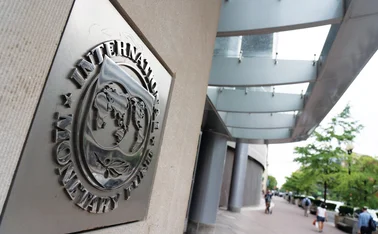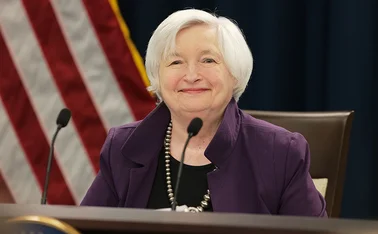
Robert Pringle’s Viewpoint: ECB needs to play ‘chicken’ to force reform of Europe’s banks

Christine Lagarde, managing director of the International Monetary Fund (IMF), was right to use a speech before the start of the annual meetings to call for more rapid progress in financial sector reform. The current model remains ‘dysfunctional'.
Yet five years after the worst of the crisis, the search for a more viable model is, as Lagarde said, ‘mission not accomplished'. Progress is stymied not only by the complexity and delay (a euphemism for bank lobbying?) but also by growing divergence in regulatory approaches.
"We have already seen some evidence of discrepancies in capital requirements. Different countries have also taken different approaches to business model restrictions, such as the Volcker Rule in the United States," Lagarde said.
The IMF head pointed out that the economics of banking are changing and it is likely that large banks will retreat from some areas, as their business models adapt to changing circumstances. Monetary policies have bought time, but the time needs to be well used. In this it is directly comparable to IMF conditional assistance to sovereigns.
Lagarde could have gone much further in her critique.
Measures taken during and since the crisis have in some ways made the situation worse, notably by protecting existing banking structures and slowing down needed changes. Banking nationalism is on the rise (see Nicolas Véron's Banking Nationalism and the European Crisis). All banks, good and bad, have received support, notably through the provision of ultra-cheap liquidity that they can invest longer term to earn a running yield. Much has been made of the interest rate risk. Yet if exit from quantitative easing (QE) is accompanied by a sharp rise in rates, threatening their solvency or liquidity, bankers are likely to demand that governments support them again.
Banking needs to be restructured in all major centres – including the US, China and Japan – but nowhere more urgently than in Europe. Lagarde's compatriot Benoît Coeuré, a member of the European Central Bank's (ECB) executive board (and front-runner to succeed Christian Noyer as Banque de France governor in due course) has also recently warned banks against using the ECB's provision of liquidity to sustain flawed business models (ECB's Cœuré backs committed liquidity facility). Equally, ECB president Mario Draghi has said that any new long-term refinancing operation should not be used as a substitute for larger capital.
Official action since the crisis has served to prop up weak banks, allowing them to continue rolling over non-performing loans to weak companies and denying credit to economic sectors that should expand. In Europe, markets are fragmented by banks' different credit standing as well as by the weak credits of peripheral countries.
A new IMF working paper, Fragmentation and Monetary Policy in the Euro Area by Ali Al-Eyd and S Pelin Berkmen, enumerates the familiar wish-list of reforms. Repairing bank balance sheets and making further progress on banking union are "essential to restore confidence in the financial system, weaken bank-sovereign links, reduce fragmentation and support credit and growth".
Policy-maker dilemma
But the paper neatly illustrates the dilemmas facing policy-makers. The short-term measures it advocates are bound to have the effect of allowing governments to postpone structural reforms. In calling for further measures to support credit supply, it argues that monetary policy should support demand to the fullest extent, providing "breathing space" for reforms while reinforcing the support provided by fiscal policies and structural reform efforts at the national levels.
It admits that these would entail additional ECB balance sheet risks, but argues that this "should not inhibit further needed action" to maintain monetary demand. Such risks, it argues, could be addressed either through offsetting measures (as in the case of recent changes to the ECB's collateral policies) or "sustained through gains to financial stability and/or the ECB's ability to maintain a protracted investment horizon" – i.e. wait indefinitely for its loans to be repaid. At a minimum, the paper says, the ECB could take further action to support liquidity to weak banks.
This is the medicine that we have tried and that has not worked. It allows banks with unviable business models to survive indefinitely. A similar criticism can be made of a recent paper by Marco Buti, director-general for economic and financial affairs at the European Commission and Pier Carlo Padoan, OECD deputy secretary-general and chief economist. Like the IMF, they argue for recognition of the true state of bank balance sheets and proper recapitalisation where needed. The forthcoming asset quality review and stress tests, ahead of the move to a single supervision authority in Europe, "will have to be carried out earnestly and credibly". Recapitalisation will have to be "underpinned by appropriate backstops". They call for completion of a fully-fledged banking union and a single centralised mechanism for the supervision and restructuring of banks, "with a common resolution fund and a common fiscal backstop".
But where will the financing come from – and the political impetus to reform? These authors seem to have no answer to such questions.
In his booklet, Austerity: European Democracies Against the Wall, Lorenzo Bini-Smaghi, former ECB board member, has written a powerful essay showing – among other things – how the ECB had to play a dangerous game of ‘chicken' with governments before they agreed in 2010 to set up a bail-out fund with macro-economic conditionality to manage the Greek crisis (forming the core of what would become the European Stability Mechanism). Now the ECB should apply the same approach to financial sector reform. This is an even more delicate and highly political game of brinkmanship.
ECB officials are talking tough
Of course everybody agrees with Francesco Papadia, former head of the ECB's market operations, that the ECB must ensure the stress-tests and asset quality review are credible. Yet what happens if the "credible" appraisal reveals a hole in the banking balance sheet far larger than could be filled by any probable combination of shareholder, bondholder, market, industry or official financing? Revealing such a gap – say, in the low trillions of euros – without a plan to address it would be deeply destabilising. That is why current plans lack credibility.
It is encouraging that current top officials are talking tough:
"We will not start before governments have agreed on a backstop – emergency funding for capital holes – which we might find in the balance sheets," Yves Mersch, the member of the ECB's executive board in charge of supervision, has said. Peter Praet, ECB executive board member and chief economist, has usefully emphasised the need to delink banks from sovereigns while stopping short of endorsing the path-breaking proposal by Jens Weidmann, president of the Bundesbank, to strip sovereign bonds of their special status and regulatory prerogatives as ‘safe' bank assets.
Europe's central banks may talk the talk, but will they walk the walk? The omens are not good. The current plan can be summarised as follows. Under the Single Supervisory Mechanism (SSM), as approved by the European Parliament, the ECB will directly supervise approximately 130 banks that are found to be ‘significant' according to the criteria laid down in the SSM regulations. The final list has yet to be drawn up but will comprise less than 5% of all active euro area banks that are the ECB's counterparts in monetary operations. However, they will account for around 85% of the total banking assets. In addition, the Commission has proposed a single bank resolution authority backed by a single resolution fund, which should be separate from the SSM, independent and supranational, and hopes to get it approved and up-and-running by April 2015. In addition, and quite separately, there is the new macro-prudential toolkit to make operational.
Prevention is better than cure
But much more is required. Given the diseased condition of Europe's financial system, the ECB cannot just be like a doctor waiting for patients to report symptoms. It has to be in the lead, actively identifying needed changes, preventing contagion, putting terminally-ill clients into palliative care and demanding that everybody under its supervision follow a healthier lifestyle. In its capacity as supervisor of the whole euro area banking system and, given the deep weaknesses likely to be revealed by the asset quality review, the ECB needs over the next year (before the launch of the new regime) to draw up a comprehensive long-term financial sector reform programme. This is necessary to ensure that piecemeal actions taken by governments as well as the central bank's agencies and the ESM encourage the far-reaching changes in the area's financial system that are required. This is necessary also as a key message to markets; that the authorities fully grasp the depth of the crisis and have a plan to address it.
Withhold liquidity until terms are met
To ensure governments agree to the plan, the ECB should make further liquidity support conditional on compliance. It can defend such an approach as crucial to its mandate. Given the risk that a number of systemically important financial institutions would become unstable in the event of a withdrawal of official support, and that further open-ended official support by the ECB would be contrary to its mandate, and arguably illegal, the process cannot be left to ‘market forces'. The plan should have three elements:
1. A clear vision of a new model of European finance – one which can be viable without expectation of official support;
2. A phased transition to the new model, involving a drastic shrinkage of traditional banking, elimination of institutions unable to attract sufficient market funding, much greater reliance on securities markets (notably equity finance) and encouragement for other alternatives to the universal banking model;
3. Agreement that individual measures at the national level to support its banking institutions during the transition must be approved by the ECB and accord with the agreed long-term plan for the sector.
Even with the best will in the world, it will take years before Europe can develop an institution with the expertise, skills, established procedures and credibility of the Federal Deposit Insurance Corporation in the US. And the task in front of the ECB goes well beyond even the FDIC's remit (through with its lack of political clout even the FDIC was unceremoniously pushed aside by politicians in the US crisis).
There is an unfortunate tendency to call for ‘adequate recapitalisation' of Europe's banks as if money can solve the problem. But it is foolish to pour more capital into any business with a bad business model. Many European financial institutions, including some of the largest and most prestigious, have bad, or at least obsolete, business models. If they can adapt quickly enough, they should be able to raise market finance. If not, they should exit the market.
Only users who have a paid subscription or are part of a corporate subscription are able to print or copy content.
To access these options, along with all other subscription benefits, please contact info@centralbanking.com or view our subscription options here: subscriptions.centralbanking.com/subscribe
You are currently unable to print this content. Please contact info@centralbanking.com to find out more.
You are currently unable to copy this content. Please contact info@centralbanking.com to find out more.
Copyright Infopro Digital Limited. All rights reserved.
As outlined in our terms and conditions, https://www.infopro-digital.com/terms-and-conditions/subscriptions/ (point 2.4), printing is limited to a single copy.
If you would like to purchase additional rights please email info@centralbanking.com test test test
Copyright Infopro Digital Limited. All rights reserved.
You may share this content using our article tools. As outlined in our terms and conditions, https://www.infopro-digital.com/terms-and-conditions/subscriptions/ (clause 2.4), an Authorised User may only make one copy of the materials for their own personal use. You must also comply with the restrictions in clause 2.5.
If you would like to purchase additional rights please email info@centralbanking.com test test test








